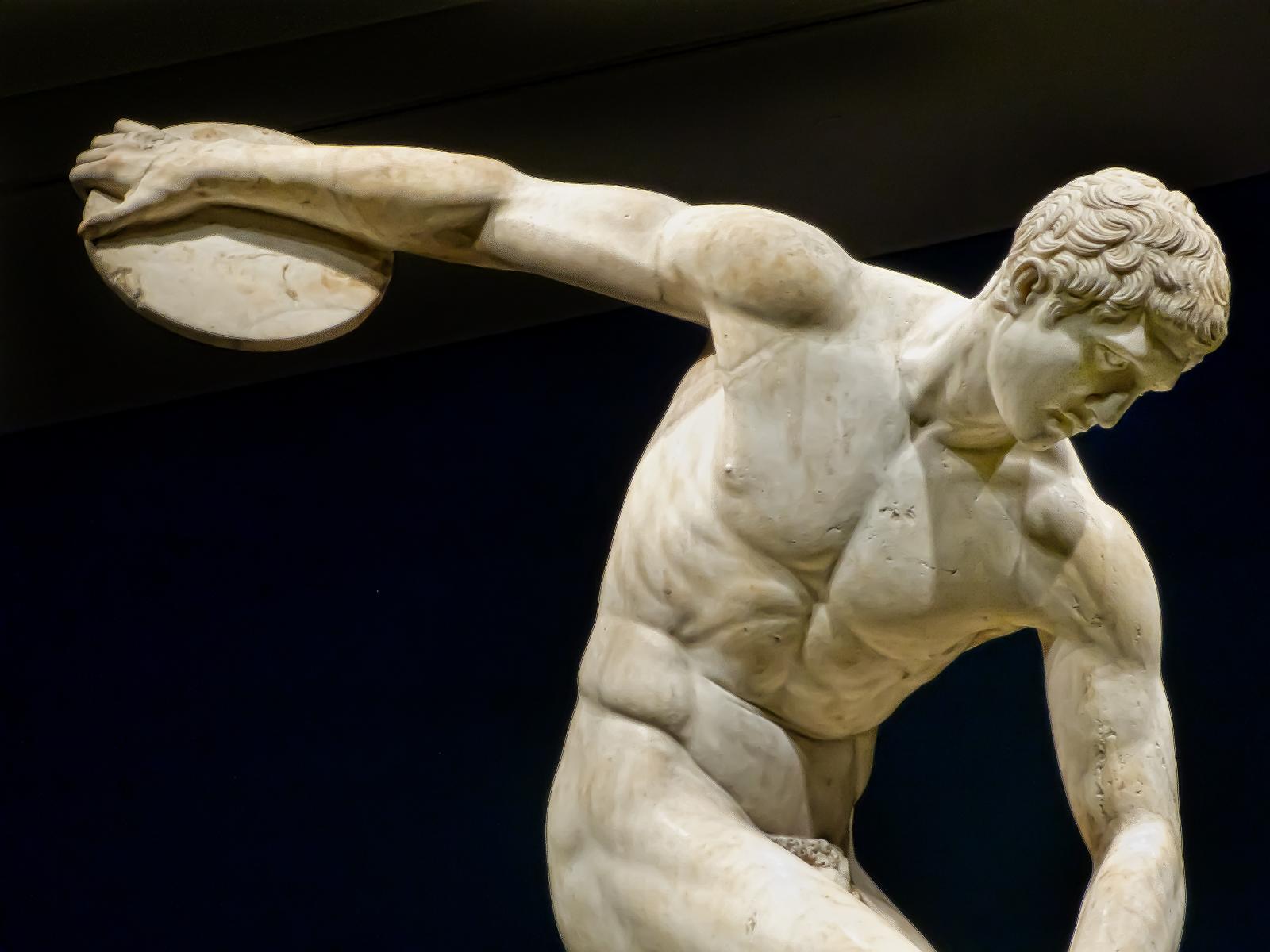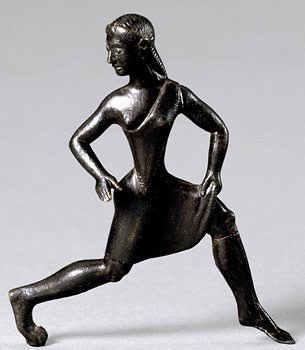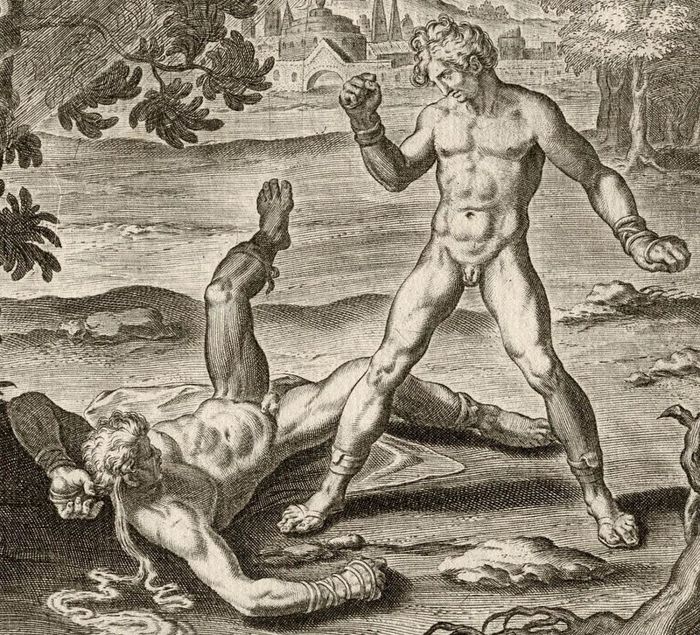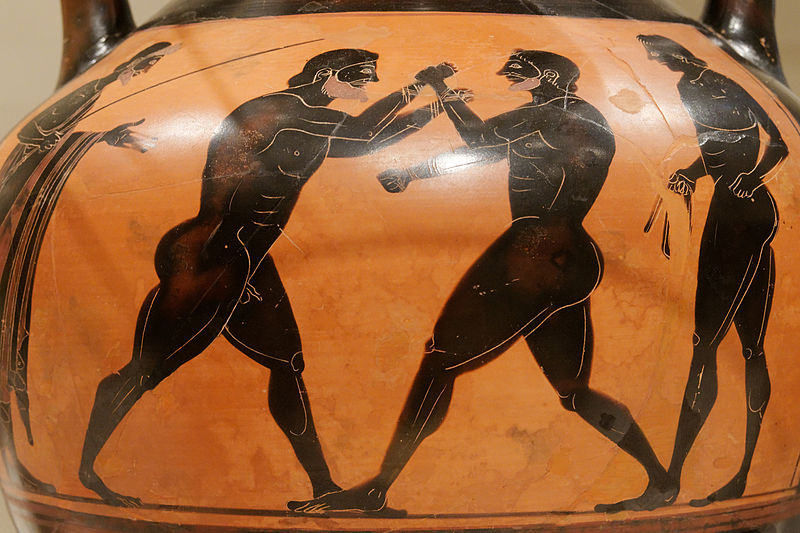Written by M. Reed Myers, Contributing Writer, Classical Wisdom
If you are like most people, you probably wonder what life would be like if you had the body of a Greek god. You wonder what doors would open for you if you had the kind of physique that only a Praxiteles would be fit to sculpt.
Wonder no more, dear reader. This article presents fitness concepts derived from the best of classical Greek sculpture, pottery, and literature, adapted for us all-too-human moderns.
Read on: adventure and heroic stature await you.
Sing. O muse, and bid your listeners consult with Asclepius before beginning any of these programs.
Think and Thrive
The gymnasia were at the center of ancient Greek physical education. Based on the word-root gymno, meaning “naked,” physical exercise at the gymnasium was done mostly in the nude, under the gaze of gymnastes, or coaches. Because the student’s body was completely observable, the coach could accurately diagnose physical limitations and develop an individualized training plan.
Archaeologists have excavated gymnasia in such sites as Athens, Delphi, Epidarus, Eretria, Olympia, and even Priene in the Greek islands. By the 5th century BC, the gymnasia offered more than just physical training. Students also received basic physical therapy, listened to lectures, watched dramatic presentations, and listened to poetic recitations. All these elements reinforced the overarching Greek culture, with a heavy emphasis on honoring the Olympian gods and semi-divine heroes.
A major problem with this system, of course, was its exclusion of women. Although Spartan women were somewhat freer, no woman in ancient Greece could exercise the same rights and freedoms as their male peers. This is not the case with these exercises. They are designed to exercise the major muscle groups and can be of benefit to either gender.
A common motif in Greek black-figure pottery was the depiction of male figures performing various exercises common to the gymnasium. Think and Thrive is a workout that builds on these art motifs to create a balanced, healthy physique with lower body, core, and upper body elements. As you progress from one exercise to the next, maintain a steady pace. Regarding exercise intensity, you should be able to speak in short sentences, but not dramatic monologues.
You will need a large open field, preferably with an oval or circular track at the perimeter, a frisbee or other throwing disk, and a weighted object you can grasp with both hands (like a kettle bell). At one side of the field, place your throwing disk, on the other side of the field place your kettle bell or other weight.
Strophe: if you are exercising by yourself and have access to audiobooks, listen to a major section of any of the following: the Iliad, Works and Days, or any of the myths of Theseus or Heracles. While listening, jog at a moderate pace around the perimeter of the field and ponder the crucial lessons you are hearing. If you do not have access to audiobooks, ask an exercise partner to chant the section aloud to you, while you jog in a smaller circle around your partner.
Antistrophe: Six sets of the following exercises.
Hurl like Hektor: Hold your flying disk in both hands, with arms extended. With your feet shoulder-width apart, and your weight balanced on both feet, slowly rotate your upper body from right to left, until you reach 100. Throughout, tighten your core and abdomen (as though you were bracing to receive a punch). When you reach 100 rotations, throw your flying disc across the field toward your kettle bell or other weight.
Run like Atalanta: While your flying disc is in the air, sprint as quickly as you can after it. Pick it up on the run and sprint with it back to your starting point. Bonus points if you are able to catch it on the fly!

Panathenaic amphora, a victory prize from ca. 530 BC depicting a foot race, attributed to the painter Euphiletos. (Metropolitan Museum of Art, New York)
Row like Jason: Before you regain your breath after your sprint, drop your flying disk and lift your kettlebell or other weight. Stand upright with your feet hip-width apart and the weight resting across your thighs. Tighten your abdomen again, pull your shoulders back, lift your chest and keep your lower back in its natural curve. Keeping the weight close to your body, pull upwards while extending your elbows. Lift the weight until it is just under your chin. Slowly lower the weight back to full extension. Breathe in and out throughout the exercise. For the basic exercise, do one repetition for each of the 12 labors of Heracles. For advanced exercise do one repetition in honor of each of the argonauts.
Epode: listen to your selection once again while jogging around the perimeter. Think about the implications of the lesson for your community and for all the Greeks. This workout can be done 3 – 4 times per week, with rest days interspersed. Alternate upper body exercises could include shoulder shrugs rather than upright rows or bicep curl to shoulder press.
The Heraean Games
Greek physical fitness was initially based on the principle that civic survival depended on having physically strong, resilient citizen soldiers. The epitome of this perspective was Sparta.
As the readers of Classical Wisdom know, Sparta’s political relevance in Greece depended on its ability to produce highly disciplined warriors who could simultaneously subdue its helot slaves and intimidate its political rivals.
It is said that when Philip II of Macedon was expanding his control over Greece in 346 BC, he sent an imperious demand to the Spartans, demanding their submission: “If I bring my forces into your land, I will ravage your homesteads, massacre your people, and destroy your city.”. The Spartans are said to have warned him off with one word: “If.”
It is worth remembering that this apocryphal encounter would have taken place about a generation after Sparta’s forces were soundly defeated by Thebes in the Battle of Leuctra (371 BC). Sparta’s diminished reputation alone was still strong enough to unnerve Philip.
One of the surprises in Spartan society was the unique status of elite women. Physical health was considered absolutely vital for the growing girl, because her health affected her ability to bear children for the Spartan state. Towards this end, girls were well fed, were encouraged to exercise, play sports, and to stay physically active throughout life. While Spartan married women did not take part in foot races, they were encouraged to dance and stay physically active.
For this workout, you will need an oval track and sandbag or other weighted sack with handles. Fill it with a weight that challenges you to complete the exercises. This work out is named in honor of the Heraean races, a pan-hellenic race for unmarried Greek women. Although the Heraean games were specifically for females, this work out can be used by either gender.
Strophe: Place your sandbag at the starting point on the track. Then, slowly jog one lap around the open field for each of the kings of Sparta. Then, proceed to forward lunges, to emulate the Spartan running girl statue: hold for 30 seconds per leg. One set for each king. Then, split stretch, as low as you can go; lean forward and hold for 30 seconds. Then, a forward bend stretch for 30 seconds to look down upon the helots.
Antistrophe: for helots, 3 sets; for maidens, 4 sets; for matrons, 5 sets.
Run 1 lap around the track.
Carrying your shield or on it: Placing your feet approximately shoulder width apart, bend forward and hold your sandbag with your arms fully extended and knees slightly bent. Keep your back in its natural curve. As you tighten your core, lift the sandbag with both arms until it almost touches your chest, then slowly lower it. Repeat the lift 8 times. That’s one set.
Run another lap around the field.
At your command: Lift the sandbag across your shoulders, feet shoulder width apart. Hold the sandbag tight against your upper shoulders but not pressing on your neck. Bend forward until your upper body is parallel to the ground. Do this eight times. That’s one set.
No further laps, Sparta has only 2 kings
Uplifting the Spartan warriors: keeping the sandbag on your shoulders, drop into a basic squat, your thighs parallel to the ground. Rise to standing. Do this eight times. That’s one set.
Epode: To cool down, jog around the track twice more. Reflect on the fact that there are eight helots for every one Spartan. This workout can be done 2-3 times per week.
The Himantes of Heaven
No discussion of ancient Greek fitness is complete without mentioning the great sporting/religious festivals of the Classical era. These included the Olympic games, Pythian games, Nemean games, and Isthmian games. Of these, the premier event was the Olympics.
The first Olympics were held around 776 BC and initially consisted of religious festivities to honor Zeus. As Pausanias notes, the games gradually expanded over time to include foot races, horse races, wrestling, boxing, pankration (a type of mixed martial art), chariot races, and the ancient pentathlon (running, jumping, wrestling, and throwing the javelin and discus). Eventually boys were allowed to compete for junior championships in several of the sports.
Among the combat sports, boxing (pygmachia) was perhaps the most celebrated. Major Greek heroes like Theseus, Heracles, and Achilles either boxed or encouraged boxing matches. Even gods got into the sport.
In the Imagenes, Philostratus the Elder recounts the tale of Phorbas, a barbarian king, who controlled a river crossing along the sacred way to Delphi. He challenged all travelers to athletic events and, being a superb athlete, bested them. While they were exhausted, he would kill them and display their heads to terrify other travelers. Apollo, in disguise, came upon Phorbas and in the ensuing boxing match, knocked the wicked bandit out with a single punch, like a bolt of fire from the heavens.
For this work out, you will need no special equipment at the basic level. If you have them, you can incorporate weighted wristbands or light hand weights. Properly thrown, punching provides exercise for the muscles of the legs, hips, sides, back, chest, shoulders and arms. If you breathe out when you punch and reflexively tighten your core, you also strengthen your abdominals and obliques.
Strophe:
Position your body in a fighting stance, that is: turned slightly away from your opponent, the wicked Phorbas. Keep your body weight evenly divided between your front and back leg, and lift onto the balls of your feet. Keep your elbows close to your body.
During the entire strophe, keep your fists up, protecting your face. The boxing gloves so frequently represented in Greek art and literature were the himantes. These were strips of ox hide wrapped around the wrists and knuckles of the boxer. They protected the wrist and knuckles, but also gashed and lacerated the opponent. Apollo’s himantes are more beautiful than garlands, says Philostratus, but when he struck Phorbas’s head, a fountain of blood gushed forth. So, keep your fists up.
Bounce gently on the balls of your feet and at random, quickly take a shuffle step in any direction while keeping your fighting stance. You can throw gentle punches if desired, but your focus is on moving quickly and frequently. Try to move forwards, backwards, right and left randomly. If you have an exercise partner, you can ask him or her to randomly call out directions. Bounce and move for 1 minute for each year between Olympics.
Antistrophe:
During this section of the workout, you will continue to rapidly move while in fighting stance, but you will also throw punches. If you have not done a boxing workout before, you may want to consult with a gymnastes for coaching.
Assume the fighting stance, and bounce on the balls of your feet. Throw 10 quick, light punches with your nondominant fist. Keep gently bouncing on the balls of your feet. You may find yourself rising slightly and leaning forward as you throw your punches. If so, move quickly back into balanced stance. After these 10 jabs, bounce and bounce and reverse your stance (so now your dominant hand is forward), throw 10 jabs with your dominant hand.
Bounce back into your original stance (with nondominant hand forward), now throw punch combinations: a fast, light punch with your front first; then, engaging your body, throw a punch with your dominant hand. Do 20 of this combination.
For the next set, now throw 30 quick jabs with your nondominant fist, then bounce and reverse your stance and throw 30 jabs with your dominant hand.
For the final set, bounce back into your original fighting stance (with nondominant hand forward). Throw 40 punch combinations: a jab with your forward fist, followed by a dominant hand punch that engages the entire body.
Epode: As with all the other workouts in this article, cool down with a slow jog. Jog for at least one minute for each of the four ancient Greek games.
The ancient Greeks well understood the importance of maintaining a healthy mind and a healthy body. And in part, exercises like these were part of the process.
Also importantly, those who lived in the classical world were more physically active than most of us today. Just a simple consideration of how we travel on land from point A to point B confirms it: getting anywhere for most Greeks meant walking; for too many of us today, it means either taking a car or a bus.
To fully incorporate classical fitness into your modern life, look for everyday opportunities to develop muscle power. Look for boulders lying about that you can roll up hill. If you happen to have a young calf at home, lift it every day. As it grows, you too will develop legendary strength.
With these and other workouts based on classical Greece, you too will be the envy of Narcissus or Helen, without their nemeses. And after a hard workout, pour yourself a tall krater of room temperature wine. You earned it.

















No comments
Trackbacks
Our apologies, you must be logged in to post a comment.